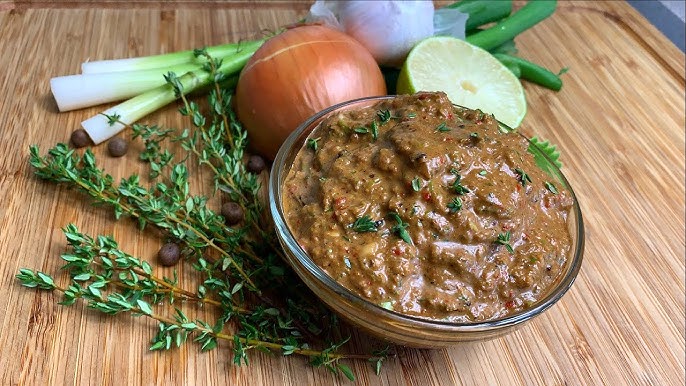Jerk Chicken Seasoning Recipe: If you’ve ever had authentic Jamaican jerk chicken, you know the flavor is unforgettable—smoky, spicy, earthy, and aromatic all at once.
The secret to this dish lies in its seasoning blend, a powerful combination of herbs, spices, and fresh ingredients that bring life to every bite.
In this step-by-step guide, you’ll learn how to make jerk chicken seasoning from scratch, marinate your chicken properly, and cook it to perfection, so you can enjoy the true taste of the Caribbean right at home.
Introduction to Jerk Chicken Seasoning
Jerk chicken isn’t just food—it’s culture, history, and passion on a plate. This traditional Jamaican dish has roots that go back hundreds of years, with influences from the Maroons (escaped African slaves) who combined African cooking techniques with native Caribbean ingredients. Over time, jerk seasoning became the signature flavor of Jamaica, celebrated across the world today.
The Origins of Jerk Seasoning
The word “jerk” comes from the Spanish word charqui, meaning dried meat. However, the Jamaican interpretation is much more complex. The Maroons developed a method of preserving and cooking meat using pimento wood (from the allspice tree) and fiery Scotch bonnet peppers. This slow-smoking process gave the meat a rich, spicy, and smoky flavor that is still cherished today.
Why Jerk Chicken is Loved Worldwide
Jerk chicken isn’t just popular in Jamaica—it’s beloved across the globe. Why? Because it’s more than just spicy food. The combination of heat, sweetness, smokiness, and freshness makes it a versatile dish that satisfies adventurous eaters and spice lovers alike. Whether you grill it at a backyard barbecue, bake it in the oven, or even cook it in an air fryer, jerk chicken always delivers bold flavors.
The Secret Behind Authentic Jerk Flavor
The key to true jerk chicken lies in the seasoning. Authentic jerk seasoning is a careful blend of fresh herbs like thyme and scallions, fiery Scotch bonnet peppers, warm spices like allspice and nutmeg, and tangy flavors from lime or vinegar. Each ingredient plays an important role in balancing the heat with depth and aroma. When prepared correctly, jerk seasoning transforms ordinary chicken into an extraordinary Caribbean feast.
Essential Ingredients You’ll Need
Before we jump into the step-by-step recipe, let’s take a look at the ingredients that make jerk seasoning so special. The beauty of this blend is how it combines pantry staples with fresh, vibrant ingredients to create a flavor explosion.
Spices and Herbs for Jerk Seasoning
At the heart of jerk seasoning are the spices. These are non-negotiables if you want that authentic taste:
- Allspice (Pimento berries): The most important spice in jerk seasoning, offering a warm, slightly sweet, and peppery flavor.
- Nutmeg and Cinnamon: Add warmth and complexity.
- Thyme (preferably fresh): Earthy and aromatic.
- Black Pepper and Salt: Essential for balance.
Fresh Ingredients That Make a Difference
While spices provide the backbone, fresh ingredients bring vibrancy and heat:
- Scotch Bonnet Peppers: These fiery chilies are the heart of jerk’s signature heat. If you can’t find them, habaneros are a decent substitute.
- Garlic and Ginger: Add depth and a zesty kick.
- Green Onions (Scallions): Fresh and mildly sharp, balancing out the richness.
- Lime Juice or Vinegar: Adds acidity to tenderize the meat and enhance flavors.
Pantry Staples You Might Already Have
You’ll also need a few everyday items that tie everything together:
- Soy Sauce: Adds umami and a touch of saltiness.
- Brown Sugar: Balances the heat with a subtle sweetness.
- Olive Oil (or any cooking oil): Helps the seasoning adhere to the chicken and keeps it moist while cooking.
Step-by-Step Guide to Making Jerk Chicken Seasoning
Now that we’ve covered the ingredients, let’s dive into how to put everything together. This step is where the magic begins, and it’s easier than you think.
Preparing the Spices
Start by measuring out your dry spices: allspice, nutmeg, cinnamon, salt, and black pepper. Lightly toasting the spices in a dry pan for a minute or two can bring out their full aroma, making your jerk seasoning even more flavorful.
Blending the Seasoning Paste
The next step is blending everything into a thick paste. Add your fresh Scotch bonnet peppers, garlic, ginger, scallions, thyme, lime juice, soy sauce, brown sugar, and olive oil into a blender or food processor. Blend until smooth but slightly chunky. The paste should be thick enough to coat the chicken without running off.
Marinating the Chicken Properly
Here’s where patience pays off. Coat your chicken generously with the jerk paste, making sure it gets into every nook and cranny. Don’t just rub it on the surface—lift the skin and massage the seasoning underneath for maximum flavor. Then, let the chicken marinate:
- Minimum time: 2 hours (for lighter flavor)
- Best results: Overnight (for full flavor penetration)
This step is what transforms your chicken from ordinary to authentic Jamaican jerk chicken.
Cooking Methods for Jerk Chicken
Once your chicken is well-marinated, it’s time to cook. Traditionally, jerk chicken is slow-grilled over pimento wood, which imparts an irresistible smoky flavor. But don’t worry—you can still achieve amazing results in your backyard grill, oven, or even an air fryer.
Grilling for Smoky Flavor
The most authentic way is grilling. Use charcoal for that smoky aroma, and if possible, toss in some pimento wood chips for extra flavor. Grill the chicken low and slow, turning occasionally until it’s cooked through with a beautiful char on the outside.
Oven-Baked Jerk Chicken
No grill? No problem. Baking jerk chicken in the oven still yields juicy, flavorful results. Preheat your oven to 375°F (190°C), place the marinated chicken on a baking sheet, and cook for 40–50 minutes. For a crispier finish, broil for the last 5 minutes.
Pan-Fried or Air Fryer Jerk Chicken
Short on time? A pan-fried version works wonders. Simply heat a bit of oil in a skillet and cook the chicken until golden brown and fully cooked. Alternatively, the air fryer is an excellent modern twist—cook at 375°F (190°C) for 25–30 minutes, flipping halfway through.
Tips for Perfect Jerk Chicken
Even the best recipes can be improved with a few pro tips. If you want your jerk chicken to taste like it came straight from Jamaica, keep these tricks in mind.
How Long to Marinate
The longer the better. Two hours is fine if you’re in a rush, but overnight marination ensures the chicken absorbs every bit of flavor. Some Jamaican chefs even recommend up to 24 hours for the deepest flavor.
Balancing Spice Levels
Not everyone can handle the fiery heat of Scotch bonnets. If you want a milder version, use fewer peppers or substitute with jalapeños. For those who love extreme heat, leave the seeds in and add an extra pepper or two.
Common Mistakes to Avoid
- Rushing the marination process: Don’t skip it.
- Overcooking the chicken: Jerk chicken should be juicy, not dry.
- Using too much sugar: A little sweetness is good, but too much will burn on the grill.
Serving Suggestions
Jerk chicken is bold, smoky, and spicy, but what you serve it with can elevate the entire dining experience. In Jamaica, jerk chicken isn’t just a standalone dish—it’s part of a feast that balances heat with refreshing sides and tropical flavors. Let’s explore the best ways to serve this classic dish.
Best Side Dishes for Jerk Chicken
The right side dish makes jerk chicken even more delicious. Some of the most authentic and popular choices include:
- Rice and Peas: This classic Jamaican side dish, made with kidney beans (or pigeon peas) and coconut milk, balances the heat of jerk chicken with creamy, subtle flavors.
- Fried Plantains: Sweet, caramelized plantains provide the perfect contrast to spicy jerk.
- Festival (Jamaican Fried Dumplings): Slightly sweet and crisp on the outside, soft on the inside—ideal for soaking up jerk juices.
- Coleslaw: A crunchy, refreshing side that cools down the spice.
- Corn on the Cob: Grilled corn with butter and a sprinkle of lime is a natural pairing.
Drinks That Pair Well
Since jerk chicken packs heat, drinks that cool and refresh are the perfect companions. Think tropical and light:
- Rum Punch: A fruity, rum-based cocktail with citrus notes.
- Red Stripe Beer: Jamaica’s famous lager that pairs perfectly with grilled jerk chicken.
- Fresh Coconut Water: Naturally hydrating and refreshing.
- Homemade Lemonade or Limeade: The acidity helps cut through the spice and richness.
Presentation Tips
They say you eat with your eyes first, and jerk chicken looks as amazing as it tastes. To serve it beautifully:
- Place the chicken on a wooden board or platter.
- Garnish with fresh thyme sprigs, lime wedges, and sliced Scotch bonnet peppers (for decoration).
- Serve family-style with rice and peas and fried plantains on the side.
With these presentation ideas, your jerk chicken meal won’t just taste authentic—it will look like it came straight out of a Caribbean restaurant.
Storing and Preserving Jerk Seasoning
One of the best things about making jerk seasoning is that you can prepare it in bulk and use it whenever the craving strikes. With proper storage, you’ll always have authentic jerk flavors ready to go.
Refrigeration and Shelf Life
If you’ve made a fresh batch of wet jerk seasoning paste, store it in an airtight glass jar in the refrigerator. It will last about 1–2 weeks without losing flavor. Make sure to keep it tightly sealed to prevent air exposure.
Freezing for Long-Term Storage
For longer storage, freezing is your best bet. Spoon the jerk paste into ice cube trays, freeze them, then transfer the cubes into a freezer-safe bag. This way, you can use individual portions whenever you want. Frozen jerk seasoning can last up to 3–4 months while retaining its bold flavors.
Homemade vs. Store-Bought
While store-bought jerk seasoning can be convenient, nothing beats homemade. Store-bought options often lack the depth of fresh herbs, Scotch bonnet peppers, and lime juice. Homemade seasoning also gives you control—you can adjust the spice level, sweetness, and salt to your preference. If you must use store-bought, look for brands that use authentic ingredients without preservatives.
Variations of Jerk Seasoning
Jerk seasoning is incredibly versatile, and depending on your taste, you can tweak it to suit your preferences. From mild and kid-friendly versions to fiery blends that pack a punch, there’s a jerk seasoning for everyone.
Mild vs. Extra Spicy Jerk
The spice level of jerk chicken depends mainly on the type and quantity of peppers used. For a milder version, reduce the number of Scotch bonnet peppers or substitute them with jalapeños or bell peppers. For an extra fiery jerk, keep the seeds in the Scotch bonnets or add an additional hot pepper like a habanero.
Dry Rub vs. Wet Marinade
- Dry Rub: Uses only powdered spices and herbs. It’s convenient, stores longer, and is great for grilling.
- Wet Marinade (Paste): Combines fresh herbs, peppers, garlic, and spices blended with liquid ingredients like soy sauce and lime juice. This version infuses deeper flavor and moisture into the meat.
Both methods are delicious, but the wet marinade is closer to authentic Jamaican jerk.
Vegetarian/Vegan Adaptations
Jerk seasoning isn’t just for chicken! You can use the same seasoning on:
- Tofu or Tempeh: Marinate and grill for a smoky, spicy vegan option.
- Cauliflower or Eggplant: Roast or grill with jerk seasoning for a flavorful veggie dish.
- Plant-Based Meats: Perfect for creating a Caribbean twist on vegan BBQ.
This way, everyone—meat lovers and plant-based eaters alike—can enjoy the taste of jerk seasoning.
Nutritional Value of Jerk Chicken
Jerk chicken isn’t just packed with flavor—it also offers a variety of nutrients thanks to its fresh herbs, spices, and lean protein. Let’s break down why this dish can be both indulgent and nutritious.
Health Benefits of Key Ingredients
- Allspice: Rich in antioxidants that support immune health.
- Garlic & Ginger: Known for anti-inflammatory and digestive benefits.
- Thyme: Contains antibacterial properties and vitamin C.
- Scotch Bonnet Peppers: High in vitamin C and capsaicin, which may boost metabolism.
Calories and Macros
On average, one serving of jerk chicken (a thigh or breast with skin) contains:
- Calories: 250–350 (depending on cut and cooking method)
- Protein: 25–30g
- Fat: 15–20g
- Carbohydrates: 3–5g (mostly from marinade ingredients like sugar and soy sauce)
It’s a high-protein dish that can fit into most balanced diets.
How to Make It Healthier
If you want a lighter version of jerk chicken, here are some tips:
- Use skinless chicken breasts instead of thighs for lower fat content.
- Reduce or omit sugar in the marinade.
- Bake or air fry instead of deep frying or using excess oil.
- Pair with nutrient-rich sides like roasted vegetables or quinoa instead of fried plantains.
This way, you can still enjoy authentic jerk flavors without compromising your health goals.
FAQs about Jerk Chicken Seasoning Recipe
1. What is the difference between jerk seasoning and Cajun seasoning?
While both blends are spicy and flavorful, they come from very different culinary traditions. Jerk seasoning is Jamaican, relying heavily on Scotch bonnet peppers, allspice, thyme, and fresh herbs. It delivers a smoky, fiery, and slightly sweet profile. Cajun seasoning, on the other hand, comes from Louisiana and leans on paprika, cayenne pepper, garlic powder, and oregano. Cajun is earthy and peppery, while jerk is herbal and tropical in flavor.
2. Can I use jerk seasoning on meats other than chicken?
Absolutely! While chicken is the most popular protein for jerk seasoning, you can use the blend on:
- Pork (especially pork shoulder or ribs)
- Fish (snapper, salmon, or mahi-mahi)
- Shrimp or lobster
- Beef cuts like flank steak
Vegetarians can use it on roasted veggies, tofu, or even jackfruit. The bold flavors adapt beautifully to different proteins and ingredients.
3. How spicy is jerk chicken?
The spiciness of jerk chicken depends on the number of Scotch bonnet peppers used. Traditionally, jerk chicken is very spicy, but you can always adjust the heat to your liking. If you want a milder version, reduce the peppers, remove the seeds, or swap them for jalapeños. On the flip side, for heat lovers, leaving the seeds in or adding extra Scotch bonnets can take it up a notch.
4. What is the best substitute for Scotch bonnet peppers?
If Scotch bonnets aren’t available in your area, the best substitutes are:
- Habanero peppers: Very similar in heat and fruity flavor.
- Jalapeños or serrano peppers: Milder alternatives if you want less spice.
- Red chili flakes or cayenne pepper: Can work in a pinch for heat, but lack the fruity flavor.
While substitutes work, nothing matches the authentic taste of Scotch bonnets in jerk seasoning.
5. Can I make jerk seasoning in bulk?
Yes! Making jerk seasoning in bulk is a great time-saver. Prepare a large batch of the wet paste and freeze it in small portions, or make a dry rub version (without fresh ingredients) that can last several months in an airtight jar. Bulk seasoning is especially handy if you cook jerk chicken often or want to use it for different recipes like jerk shrimp, jerk pork, or jerk vegetables.
Conclusion
By now, you’ve learned everything you need: the essential ingredients, how to prepare the seasoning paste, the best ways to marinate and cook your chicken, and even tips on storing, serving, and experimenting with variations. Whether you prefer it grilled, oven-baked, or air-fried, jerk chicken never fails to impress your taste buds.
The beauty of making your own jerk seasoning lies in its flexibility. You can dial up the spice, keep it mild, make it into a dry rub, or even adapt it for vegetarian dishes. Every batch you prepare will bring a little piece of Jamaica to your table.
So fire up the grill (or oven), grab your spices, and dive into the world of jerk chicken. Once you’ve tried this homemade seasoning, you’ll understand why it’s beloved worldwide—and why making it from scratch is always worth the effort.



